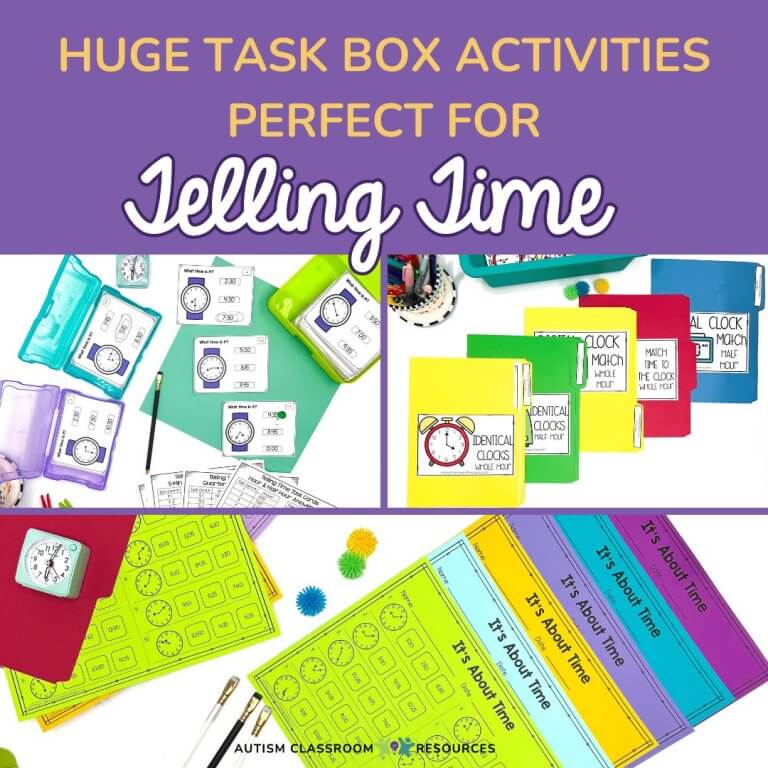This life skills math task box idea will be great for any students who need to work on measuring using measuring cups, spoons and other tools in the kitchen. This is a great opportunity for students to practice measuring dry ingredients (although you could add wet ingredients depending on the mess factor) using a variety of tools.
I really love this life skills math task because measuring is something I find students learn more successfully when it’s hands-on for them. Abstract worksheets are ok for practice, but they don’t substitute for actually using a measuring cup or a measuring spoon.
As with most task boxes, you can make this task easier or harder with different tweaks.
- You could start with just measuring by cups and then add in half, quarter and eighth cup measurements
- You could use just measuring spoons or just measuring cups
- Add in measurements that include both a measuring cup and a spoon (e.g., 2 cups and 2 teaspoons). I work with recipes that often include measurements like this.
- Have the students add the measurements in the assignment and use measures (e.g., told to measure out 1/4 cup of rice and 1/2 cup of rice, means they should measure 3/4 cups of rice).
- Use muffin tins (preferably with a lid) to have students put consistent amounts in each cup of the tin
Independent Work Inspiration: Material List
This post includes affiliate links. Same price for you, but I receive a small commission. But I only recommend products I would use and buy.
- Gather larger and smaller containers together from deli containers, margarine containers, or any type of container with that has a secure top. The secure top is important because you don’t want it to spill out so you can check it. If you need to purchase some, this set has different size containers and containers with multiple areas for more expansion of the system.

- You can also use zip lock bags if your students can close them securely. If you use them, just be sure your students can work with 2 hands efficiently to hold open the bag and pour in the beans or rice. The new stay-open bag option with a stand-up bottom might be helpful here.
- Make sure you have 1 large container to hold the rice or the beans you are using for the students to measure
- A set of measuring cups like these with easy to read text.
- A set of measuring spoons like these
- Rice or beans you will use to have the students meaure
[socialpug_tweet tweet=”These life skills math task boxes are great for your students to practice dry measurement in the kitchen with limited amounts of mess in their independent work system. Check the video tutorial. #IWinspiration #taskboxes #TEACCH” display_tweet=”These life skills math task boxes are great for your students to practice dry measurement in the kitchen with limited amounts of mess in their independent work system. Check the video tutorial.” style=”2″]
Life Skills Math Task Box: Who Are They For?
This set of task boxes will be perfect for students from elementary through adulthood. Any classroom working on life skills math with cooking and similar tasks will benefit from practicing accurately how to measure dry ingredients.
Office Work Task Box Video Tutorial

Tips for the Life Skills Math Measuring Task Box
Start students with just measuring spoons or measuring cups, depending on which you think will fit their fine motor needs better and which ones match the skills you ahve taught. As always, make sure that the student has mastered measuring the tasks before putting them in independent work. Want to know why? Check this post.

You need something to label the containers with the amount of rice or beans you want the student to put in the container. I used masking tape and a permanent marker because it was fast. You could use a label maker or use Velcro cards with different measurements to make it easy to change up the requirements regularly.
Students then have to use the cups and/ or the spoons to measure the amounts into the designated container and close the container. It goes into the finished area closed (here’s why). One of the primary reasons in this particular task is that you can check the student’s work easily when resetting the task by using the same measuring implement (i.e., spoon or cup) to put the rice or the beans back into the large container.
Finally, you may want to put a large sheet or some type of cover on the floor to catch the fallen rice or beans. Obviously sometimes this task can get messy and that can make clean up a bit easier.
Need more ideas for task boxes? Check out the resources below.
These kits include an e-book with directions on setting up independent work systems and using the materials included, data sheets for tracking progress, visuals for the special education work boxes and schedules, what’s next visuals, and mastery sheets to keep track of which students have mastered which task.
In addition, each has age-relevant materials for early childhood (left) or life skills (right) tasks already designed and ready to print out and assemble.








![Independent Work-3 Ways It can Become Your Best Classroom Management Tool [A sorting task in a shoebox to sort nouns from verbs on popsicle sticks into plastic cups]](https://autismclassroomresources.com/wp-content/uploads/2023/06/BLOG-22208-3-Ways-Task-Boxes-and-IW-Help-Classroom-Management-2-768x644.jpg)
